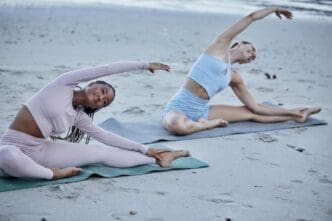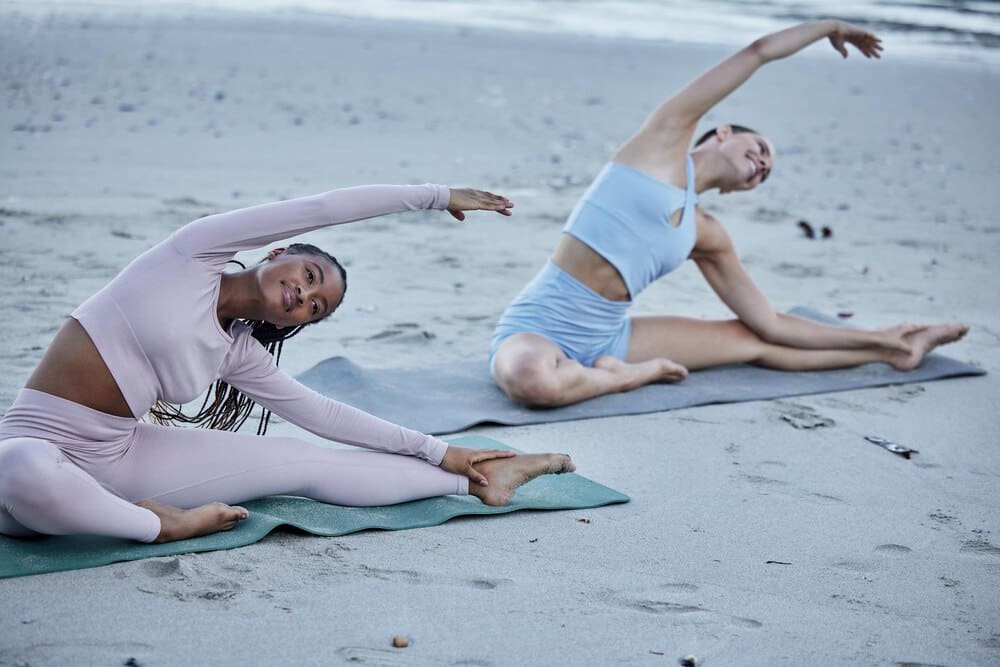For runners pounding the pavement and bridges from Miami to Palm Beach, the unique demands of South Florida’s heat, humidity, and pancake-flat terrain require a smarter, more holistic approach to training. This is where yoga comes in, serving as a powerful, science-backed tool for local athletes seeking to enhance performance, prevent common injuries, and build sustainable longevity in the sport. By integrating a consistent yoga practice into their routine, runners can unlock significant gains in flexibility, core strength, breathing efficiency, and mental fortitude, transforming their relationship with running from a grueling battle against the elements into a more fluid and resilient pursuit.
The Synergy Between Pavement and Mat
Running is a repetitive, high-impact activity that creates predictable patterns of tightness and imbalance in the body. Every stride shortens the hamstrings, tightens the hip flexors, and puts immense stress on the joints. Over time, these effects can lead to a shortened stride, poor form, and a host of common running injuries.
Yoga acts as the perfect counterbalance. It is a low-impact discipline focused on moving the body through its full range of motion, building strength in stabilizing muscles, and fostering a deep connection between mind and body. It doesn’t just stretch the muscles that running tightens; it strengthens the muscles that running neglects, creating a more balanced and resilient athlete.
Core Pillars: How Yoga Directly Benefits Runners
Integrating yoga isn’t just about feeling good after a tough workout; it delivers tangible physiological benefits that translate directly to faster times, fewer injuries, and better recovery.
Improved Flexibility and Range of Motion
The most obvious benefit is increased flexibility. Chronic tightness in the hamstrings, quadriceps, and hip flexors is a trademark of many runners. This tightness restricts movement, shortens your stride, and forces other parts of your body to compensate, often leading to pain in the lower back or knees.
Yoga poses, or asanas, are designed to systematically lengthen these muscle groups. Poses like Pigeon Pose specifically target the deep hip rotators and piriformis muscle, a common source of sciatic-like pain in runners. Downward-Facing Dog provides a comprehensive stretch for the entire back of the body, from the calves to the hamstrings and up through the spine.
This increased flexibility allows for a longer, more efficient running stride. With less muscular resistance, your body can move more freely, conserving energy and allowing for greater power with each footfall.
Enhanced Core Strength and Stability
A strong core is the foundation of good running form. Your core—which includes your abdominals, obliques, and lower back—stabilizes your pelvis and torso, preventing excess side-to-side or rotational movement as you run. When your core is weak, your form breaks down as you fatigue, leading to wasted energy and increased injury risk.
While crunches have their place, yoga builds functional core strength in a three-dimensional way. Poses like Plank, Boat Pose (Navasana), and Warrior III (Virabhadrasana III) force you to engage your entire core to maintain balance and alignment. This translates directly to maintaining a stable, upright posture during the final, grueling miles of a run through South Florida’s humidity.
Proactive Injury Prevention
Many running injuries, from IT band syndrome to plantar fasciitis and runner’s knee, are ultimately caused by muscular imbalances and overuse. Yoga is one of the most effective modalities for addressing these root causes.
By stretching tight muscle groups and strengthening weak ones, yoga helps restore musculoskeletal balance. For example, strengthening the gluteus medius through balancing poses can help prevent the hip drop that often contributes to IT band issues. Furthermore, yoga improves proprioception—your body’s awareness of its position in space—which can help prevent ankle rolls on uneven surfaces.
Superior Breath Control and Endurance
The humid, heavy air of South Florida can make breathing feel like a chore during a run. Yoga places a heavy emphasis on conscious breathing, or pranayama. Learning to take deep, diaphragmatic breaths can dramatically improve your respiratory efficiency.
Most people are “chest breathers,” taking shallow breaths that only use a fraction of their lung capacity. Yogic breathing trains you to use your diaphragm, the large muscle at the base of the lungs, to pull air deep into the body. This practice increases your tidal volume and can improve your VO2 max, allowing your body to take in and utilize oxygen more effectively. This enhanced efficiency means more stamina and less breathlessness on your runs.
Crafting Your Practice: Yoga for the South Florida Runner
Not all yoga classes are created equal. Choosing the right style and timing is crucial to maximizing the benefits for your running.
Choosing the Right Style
- Vinyasa: Often called “flow” yoga, Vinyasa links breath to movement in a continuous sequence. It’s excellent for building strength, balance, and cardiovascular fitness in a way that complements the dynamic nature of running.
- Hatha: This is a slower-paced style where poses are held for longer periods. Hatha is ideal for beginners and for runners looking to focus on proper alignment and achieve a deep, targeted stretch.
- Yin or Restorative: These are the ultimate recovery tools. In Yin, passive poses are held for 3-5 minutes or more to target the deep connective tissues (fascia and ligaments). Restorative yoga uses props like bolsters and blankets to support the body in positions of complete ease, promoting deep relaxation and nervous system recovery. Schedule these classes on your rest days.
A Note on Hot Yoga in the Tropics
Practicing yoga in a heated room is popular, but South Florida runners should approach it with extreme caution. You are already acclimated to and often training in significant heat and humidity. Adding a 105-degree studio to your regimen, especially after an outdoor run, can easily lead to severe dehydration and heat exhaustion.
If you choose to practice hot yoga, do so on a day when you are not running, hydrate far more than you think you need, and listen carefully to your body’s signals to back off or leave the room.
Pre-Run vs. Post-Run Yoga
The timing of your practice matters. Before a run, your goal is to warm up the muscles, not to hold deep, static stretches, which can temporarily decrease power output.
Pre-Run: Focus on dynamic movements. A few rounds of Sun Salutations (Surya Namaskar), Cat-Cow stretches, and gentle leg swings are perfect for increasing blood flow and preparing the joints for impact.
Post-Run: This is the ideal time for static stretching. Your muscles are warm and pliable, allowing you to safely move deeper into poses. This is when you should hold your hamstring stretches, hip openers, and quad stretches for 30-60 seconds to help restore length and release tension.
Essential Yoga Poses for Every Runner
Incorporating even a few key poses into your daily routine can make a world of difference. Focus on these foundational movements.
1. Downward-Facing Dog (Adho Mukha Svanasana)
This quintessential yoga pose is a full-body reset for runners. It stretches the hamstrings, calves, arches of the feet, and shoulders while strengthening the arms and upper back. Gently “pedaling” the feet by bending one knee and then the other can deepen the stretch in each calf.
2. Low Lunge (Anjaneyasana)
Sitting at desks and then running shortens the hip flexors, which can lead to lower back pain and a restricted stride. The Low Lunge provides a deep, targeted release for the psoas and other hip flexor muscles. Ensure your front knee is stacked directly over your ankle to protect the joint.
3. Pigeon Pose (Eka Pada Rajakapotasana)
A runner’s best friend for tight hips. Pigeon Pose stretches the deep external rotators of the hip, including the piriformis muscle. Releasing this area can alleviate sciatic-like pain and improve hip mobility. If the full pose is too intense, a figure-four stretch on your back is an excellent modification.
4. Triangle Pose (Trikonasana)
Triangle Pose is a multi-tasking marvel. It stretches the hamstrings, groins, and hips while also opening the chest and shoulders, which can become rounded from running. This pose encourages better posture and thoracic mobility.
5. Bridge Pose (Setu Bandhasana)
Running develops the hamstrings, but often neglects the glutes. Weak glutes can lead to hamstring and lower back injuries. Bridge Pose is a simple yet powerful way to activate and strengthen the glutes and hamstrings while gently stretching the chest and hip flexors.
The Final Mile: Yoga for Mental Endurance
Beyond the physical, yoga cultivates mental resilience. The practice teaches you to stay present and calm while holding a challenging pose, using your breath as an anchor. This skill is directly transferable to running.
When you hit “the wall” during a race or a tough workout, the ability to quiet your mind, focus on your breath, and stay present with the discomfort can be the difference between pushing through and giving up. The final resting pose of every yoga class, Savasana, trains your nervous system to switch from a state of stress to one of deep rest and recovery—a vital skill for any serious athlete.
For the South Florida runner, yoga is not an indulgence but a strategic component of intelligent training. It builds a more durable, efficient, and balanced body capable of handling the demands of the environment. By embracing the mat, you are not taking time away from your running; you are investing in a longer, stronger, and more fulfilling running journey.







